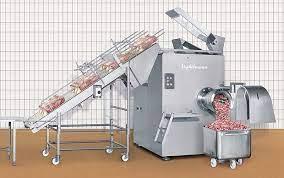Meat processing is the collection of activities that turn slaughtered animals into finished meat products. It generally involves four distinct steps: slaughter, all of which take place at a slaughterhouse; carcass dressing (or carcass preparation); cutting and fabrication; and packaging and labeling.
- Methods to Process Meat:
Slaughtering: The first step in meat processing is slaughter. This usually happens at a slaughterhouse, although on some occasions it may be done at the premises where the animal was raised.
Carcass dressing: The second step is carcass dressing (or carcass preparation). This is when the animal’s skin is removed and the carcass is divided into smaller cuts.
Cutting: The third step is cutting and fabrication. This is when the meat is cut into smaller pieces, such as steaks or chops.
Packaging: Finally, the fourth step is packaging and labeling. This is when the meat is packaged for sale and labeled with essential information, such as the type of meat, the weight, and the country of origin.
- Role in Food Safety:
Meat processing is a critical part of the food industry, and it plays a vital role in ensuring that safe, high-quality meat products are available to consumers. The end goal is to produce safe, flavorful, and nutritious meat products that can be enjoyed by consumers around the world. Meat processors must adhere to strict safety and quality standards in order to ensure that their products meet these goals.
- Meat Processing Machinery Used at Industrial level:
There are a variety of meat processing machinery used at the industrial level in order to create products such as hot dogs, ham, and Bacon.
Tumbler: The most common type of machine is the tumbler, which is used to mix together ground meat, spices, and other ingredients.
Meat Rollers: The mixture is placed into casings and fed through a series of rollers that compress and shape it into the desired product. Finally, the product is cooked and packaged for sale.
Meat Grinders: Other common machines include grinders, which are used to break down larger pieces of meat into smaller pieces; choppers, which are used to dice meat; and mixers, which are used to thoroughly blend ingredients together.
These machines play an essential role in the meat processing industry, and are responsible for creating the products that we enjoy on a daily basis.
- Advantages of Meat Processing by machinery:
Meat processing has a number of advantages that make it an increasingly popular choice for many consumers.
Increases the Shelf of meat:
One of the primary advantages of meat processing is the increased shelf life that it offers. By removing excess fat and water, meat processors are able to create a product that can be stored for longer periods of time without spoilage.
Improve Texture:
Meat processing can also help to improve the taste and texture of certain meats. By carefully removing certain organs and blood vessels, processors are able to create a more tender and flavorful product.
Reduce waste and Cost effective:
Meat processing machinery can also help to lower the overall cost of meat consumption. By reducing waste and maximizing the use of each carcass, processors are able to sell their products at a lower price point. As a result, meat processing provides a number of benefits that make it an attractive option for many consumers.
Conclusion:
Meat processing is a critical part of the food industry, and it plays a vital role in ensuring that safe, high-quality meat products are available to consumers. The end goal is to produce safe, flavorful, and nutritious meat products that can be enjoyed by consumers around the world.

